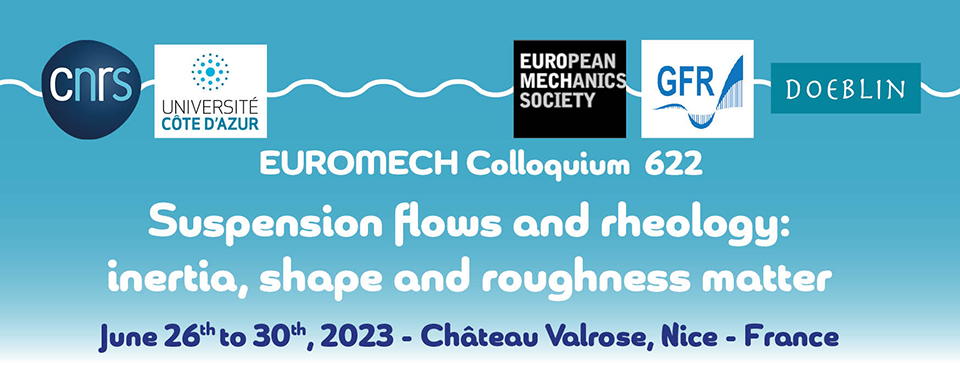
|
|
|
Suspension flows and rheology: inertia, shape and roughness matter
This EuroMech Colloquium is organized by:
E. Climent (IMFT), E. Keaveny (Imperial College), E. Lemaire (InPhyNi), M. Abbas (LGC)

Purpose of the colloquium: Particle-laden flows span scales ranging from the microscopic fluid-structure interactions observed in cellular biology and microsystems, to the large-scale transport of sediments by turbulent environmental flows and engineering processes. The coupled dynamics of the continuous fluid phase and the particles has been a longstanding topic of research in physics and (mechanical, chemical, aerospace) engineering departments. Recent outcomes were achieved by comparing dedicated experiments to numerical simulations which became more and more realistic due to new algorithms and their accurate and scalable implementation on high performance computing facilities.
Although particulate flows are involved in large scale applications, the complex nature of their behaviour originates at the particle length scale, making the characteristic Reynolds number to be small or moderate. At the scale of particles, many physical effects drive the response of the suspension including multi-body hydrodynamic interactions, lubrication and non-hydrodynamic effects such as friction and DLVO forces (repulsion or attraction). The very small particles also experiencing Brownian diffusion which couple with hydrodynamic interactions. Fundamental to understanding these processes are computational methods and numerical techniques that enable large-scale simulation of scenarios that span different flow regimes from Stokesian dynamics to granular media dominated by particle contacts. These techniques must account for experimental evidence that relates the local nature of particle interactions to a continuum-level rheological model. In particular, small variations in physical-chemical properties (e.g. particle surface roughness, van der Waals forces) may result in drastic changes of the suspension dynamics such as particle migration together with aggregation, shear-thinning or discontinuous shear-thickening.
The past 30 years have seen great progress in a diverse set of computational techniques, including LBM, IBM, FCM, DPD, SPH, SD and others, as well as the development of new experimental methods including local rheometry (X-ray, MRI, suspension imaging), controlled particle pressure measurements, microscopic contact law determination... However, there is a lack of discussion and interaction between the groups of researchers developing these experimental or numerical methods. Yet these could lead to a better picture of the relevant mechanisms in suspension flows and a global perspective of the advantages and disadvantages of each numerical method and its specific validity regime in terms of Reynolds number, volumetric concentration of particles, surface roughness or physico-chemical properties.
The purpose of this colloquium will be to gather the leading experts in experimental and computational methods for low Reynolds number particulate flows to share the state-of-the-art progress and compare techniques and results.
Scientific committee
- Arezoo ARDEKANI - Purdue Univ. , USA
- Gerhard GOMPPER - Forschungszentrum Jülich, Germany
- Sarah HORMOZI - Cornell Univ. , USA
- Lucio ISA - ETH Zurich, Switzerland
- Fredrik LUNDELL - KTH Stockholm, Sweden
- Romain MARI - LIPhy Grenoble - France
- Bloen METZGER - IUSTI Marseille - France
- Ignacio PAGONABARAGA - EPFL Lausanne, Switzerland
Scientific topics
- Low Reynolds suspensions: from single particle to collective behavior
Brownian and Non-Brownian particles
Colloidal dispersion
Effect of non-hydrodynamic forces
Active suspensions
- Effect of particle shape
Non-spherical particles
Polar or nematic order
Deformable objects (droplets, cells, soft particles ...)
- Particle migration
Inertial effects
Shear or concentration induced migration
- Solid contact (roughness, friction, adhesion, rebound)
- Non viscosimetric flows (extension, jet, ...)
- Non-Newtonian fluids

